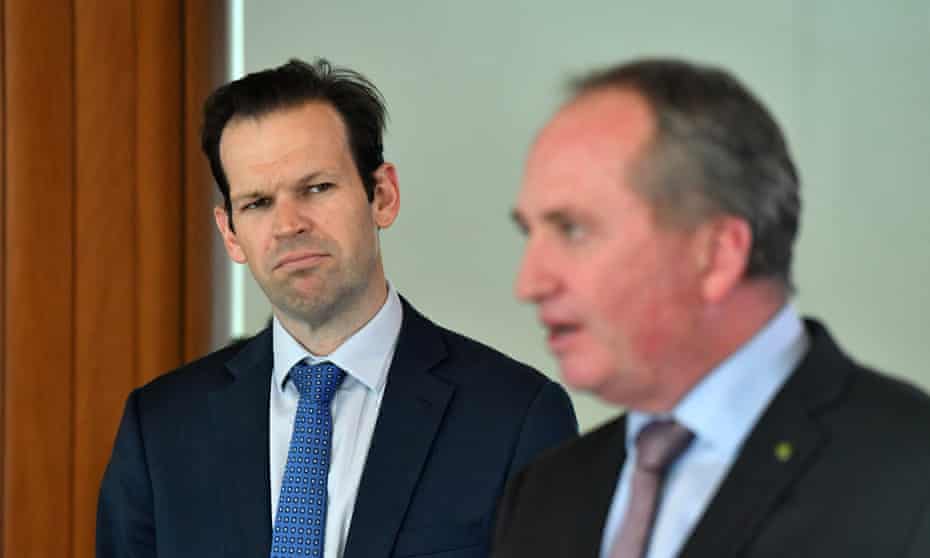
In postmortem interviews, the Liberals and Nationals are debating what they should do differently on the core issue of the climate crisis after losing a wave of seats to pro-climate Greens, independents and a Labor party with bolder climate targets.
One of the loudest voices on climate in Coalition ranks in recent days has been Liberal National party senator Matt Canavan, who blamed the Morrison government’s endorsement of a goal to reach net zero greenhouse gas emissions by 2050 as a key reason for its downfall.
But in making his claims, the pro-coal Queensland senator has insisted that countries around the world are walking away from net zero and that it is a “failed agenda”.
“It’s clearly failed around the world that European countries are already moving away from it,” said Canavan. “I’m not going to apologise for saying the truth, net zero is a failed agenda.”
Canavan is an ally of the current Nationals leader, Barnaby Joyce, who has suggested the National’s may drop its support for net zero altogether.
But is there any evidence to support Canavan’s claims that countries are moving away from net zero, particularly in Europe, or that the agenda is dead?
According to Net Zero Tracker, a project run by a consortium of groups including Oxford University, Canavan’s “dead” net zero movement is broadly adopted by more than 120 countries covering about 90% of global GDP.
“The claim that European nations are moving away from net zero is laughably untrue,” says Richard Black, co-lead of Net Zero Tracker from the Energy and Climate Change Intelligence Unit.
“Most of those that historically queried decarbonisation -Poland, Czechia, Slovakia – are now firmly in favour of it – Vladimir Putin has seen to that.
“Some countries and the EU itself are bidding to secure oil and gas supplies from countries other than Russia but this is dwarfed by activities that will speed decarbonisation – investing in energy efficiency, renewables, green hydrogen and so on.”
Black told Temperature Check his latest assessments showed 127 countries now had net zero pledges but there was a wide variation in the rigour of the targets ranging from simple statements to legislated plans and compliance mechanisms.
“But that picture has changed a lot over the last 12 months, and the next update from the Net Zero Tracker [due next month] will reflect the fact that many more governments have put their pledges in official policy documents.”
The argument from some on the Australian right that the Coalition had lost because of its support for net zero was “risible”, he said.
Loose Bolt
News Corp Australia political commentator and Sky News host Andrew Bolt was livid at the temerity of tech billionaire Mike Cannon-Brookes this week, who Bolt claimed had suggested everyday Australians could afford to spend $100,000 to completely electrify their homes.
“People don’t have $100,000 to go green,” said Bolt. “A small price to pay for saving the planet or barking insane?”
Bolt tried to frame the comments as a demonstration that Cannon-Brookes’ wealth meant he was out of touch, and that this $100,000 represented his “plan”. But this wasn’t what Cannon-Brookes said, and it is not his number.

First, some background. Cannon-Brookes wants to take over Australia’s biggest polluter, AGL, and his consortium said it wants to close the company’s coal plants early.
So what did Cannon-Brookes actually say? On his Sky News program, Bolt displayed a quote which he attributed to Cannon-Brookes, but which actually came from an investment memo published by Cannon-Brookes’ Grok Ventures.
It said: “Moving to 100% electric could cost the average Australian home approximately $100,000. We believe converting this capital expenditure into operating expenditure is a challenge AGL can solve for customers.”
Grok said AGL could offer finance products to customers as they electrified their homes. These estimates were not Grok’s, but came from CSIRO and the Rewiring Australia group on likely costs for an average home.
Grok told Temperature Check this estimate was a projection of the entire capital expenditure “for all assets to electrify the average residential home” and would not occur all at once. That included, for example, replacing an average 1.8 non-electric cars, buying solar PV systems, batteries and home appliances.
A Grok spokesperson said: “These assets will be added and funded to the home over a period of time, as consumers themselves drive the demand for green and affordable energy.

“There’s lots of research that validates this. Rewiring Australia shows that if Australian homes switch to 100% electricity rather than gas, their household bills could drop from $5,000 a year to $800 a year.”
Electric blah
Bolt’s fellow traveller in News Corp Australia’s climate culture wars is Daily Telegraph columnist Tim Blair, who did some maths of his own this week to try to undermine the financial rationale for buying an electric car.
Blair latched on to a tweet from re-elected Warringah independent MP Zali Steggall, which said her Hyundai Kona electric car saved her about $1,000 in petrol costs every year.
Blair said because the electric-version of the Kona was about $13,000 more expensive than its fossil fuel equivalent, “a petrol buyer would be in front financially for 13 years.”
Forgetting for a minute that some folk don’t make decisions on purely financial grounds, Blair’s calculations are likely well off and ignore the effect of Labor’s pre-election promises on EVs.
Electric cars cost less to run, less to service and head of policy at the Electric Vehicle Council, Dr Jake Whitehead, says they will hold their value better than internal combustion engine models.
According to RACV, powering an electric Kona costs $5 per 100km, compared to $12 for the petrol version (based on fuel costing $1.80 a litre). Each electric Kona service costs between $100 and $200 less than its petrol equivalent, according to RAC WA.
Whitehead said the actual difference in running costs between an electric and fossil fuel version of Steggall’s Kona was more likely in the region of $2,000 a year without factoring the difference in depreciation which he said could completely negate the extra upfront costs.
Because of existing free trade agreements, Labor’s promised removal of a 5% import tariff on electric cars would mostly only apply to European models. The more significant Labor promise was the removal of fringe benefits tax, he said.
“In the first instance this will significantly increase adoption by fleets, in turn helping to spur a second-hand market in the next three to four years. Additionally, if you can purchase a car through a salary sacrifice agreement with your employer, you will receive a significant discount on the cost of the vehicle.”

No comments:
Post a Comment